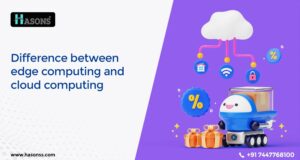Introduction
Businesses use these two common technologies increasingly often today. Each of these technologies has its advantages and its respective applications, but they are quite different from each other nonetheless. This essay will cover the key topics and compare edge and cloud computing.

What is edge computing?
Advantages of Edge Computing
It was further noted that one of the main benefits of edge computing is that it enables lower latency. Processing data closer to the source facilitates fast decision-making and provides real-time information for businesses. This is especially beneficial for processes that need real-time response, for example, in the use of automatic equipment or IT services. Also, edge computing can prevent the waste of a considerable amount of bandwidth.
Disadvantages of Edge Computing
Although edge computing has numerous advantages, there are several disadvantages. However, one primary drawback is the integration of complexity into the software. Supervising several edge devices can be a complex process, which may prove problematic to SMEs with a restricted number of IT employees on board. The next disadvantage is the one-time expenses, or capital expenditures, to be more specific.
What is cloud computing?
Edge computing, on the other hand, analyzes data on local nodes, such as routers, gateways, or even IoT devices. This includes storage, processing power, and applications that reside on machines owned and managed by third parties such as Amazon Web Services (AWS), Microsoft Azure, Google Cloud, and many others.
Advantages of cloud computing
Cloud computing uniquely features flexibility and scalability to accommodate even the largest companies. Since it is in the cloud, it becomes very easy to manage the expansion or shrinking of the overall business operations without affecting a firm’s infrastructure. Additionally, it provides cost efficiency. By so doing, businesses do not need to total large sums of money, as is the case with other payment structures such as subscription and usage-based.
Disadvantages of Cloud Computing
But like anything, cloud computing has its flaws. Among the grievances, one may list the possible latency problems. Since data has to move to other servers, it can sometimes take some time, depending on the distance between the servers. Another disadvantage is that its operation fully depends on an internet connection, just like all the other online platforms. Disturbances or cutoffs from the internet can halt today’s cloud-based activities at any time.
The Differences between Edge Computing and Cloud Computing
To better understand the distinctions between edge computing and cloud computing, let’s compare them side by side in a tabular format.
|
Conclusion
It is up to the business to decide between using edge computing and cloud computing. Edge computing can be suitable if there is a need for real-time data processing and an increased security level for the given operations. On the other hand, if you would like to have several solutions that can be set up quickly but that do not cost a lot at the beginning of the process, you should turn to cloud computing. It is with this knowledge that you will be able to decide on the best technology to embrace for your business to improve its operations.
| If you are reading Differences between Edge Computing and Cloud Computing then also check our other blogs: | |
| Types of Scanners in Computer | Data Transmission |
| Components of computer network | Network technology |
Difference Between Edge and cloud computing
